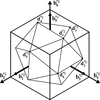issue contents
May 2015 issue

Cover illustration: Unique atom hyper-kagome order in Na4Ir3O8 [Talanov et al. (2015). Acta Cryst. A71, 301-318]. Crystals with hyper-kagome atomic order are expected to show unusual physical properties. Image courtesy of V. Talanov.
foundations
research papers
Open  access
access
 access
accessPeriodically-poled ferroelectric crystals are studied by observing their superlattice (grating) diffraction profiles with high-resolution X-ray diffraction. In order to successfully model the data, the effects of strain, and sample and beam coherence, must be taken into account.
The characterization of Bravais types is extended according to metrical, algebraic and geometric properties onto a wide class of primitive lattices (including Buerger-reduced and a substantial part of Delaunay-reduced) related to low-restricted semi-reduced descriptions. There are excellent theoretical and practical reasons for looking at crystal lattice symmetry from an entirely new point of view – the combinatorial set of 960 matrices, their semi-reduced lattice context and their geometric properties.
A structure factor for an icosahedral quasicrystal with an arbitrary decoration scheme based on a primitive icosahedral tiling model and a statistical approach is derived. The average unit cell concept is used as an alternative to the commonly used higher-dimensional description.
The application of X-ray phase measurements for absolute identification and improvement of atomic model structures is described.
The structure of a particular type of hollow-cage higher fullerene (C60+N24) is described and their construction explained from a symmetry-breaking mechanism starting from perfect icosahedral symmetry of C60 to specific subgroups A1 × A1. This mechanism expands and completes previous results describing the existence of other groups of fullerenes (C60+N10, C60+N18) based on the breaking of icosahedral symmetry of C60 to the subgroups H2 and A2. The mechanism is extended to describe the cases that generate carbon nanotubes.
Group-theoretical and thermodynamic methods of the Landau theory of phase transitions are used to investigate the hyper-kagome atomic order in structures of ordered spinels and a spinel-like Na4Ir3O8 crystal. The existence of hyper-kagome lattices in six types of ordered spinel structures is predicted theoretically.
A method from numerical algebraic geometry, called homotopy continuation, is used to determine small crystal structures of four or fewer atoms directly from a minimum set of diffraction intensities.
Combined atomic and magnetic pair distribution function (PDF) refinements have been performed against neutron scattering data from MnO, recovering the expected long-range-ordered antiferromagnetic state and supporting a scenario of monoclinic symmetry on a local length scale of ∼100 Å. This represents the first experimental application of the magnetic PDF method.
Ternary intermetallics – 13 026 compounds contained in the database Pearson's Crystal Data – are discussed with respect to their components, structure types and stoichiometries.
short communications
Physical property tensors of materials such as nanotubes or polymers are determined by the material's axial point group. Rank 1, 2, 3 and 4 property tensors are given for a wide variety of tensor types invariant under each point group in all 31 infinite series of axial point groups.


 journal menu
journal menu




























